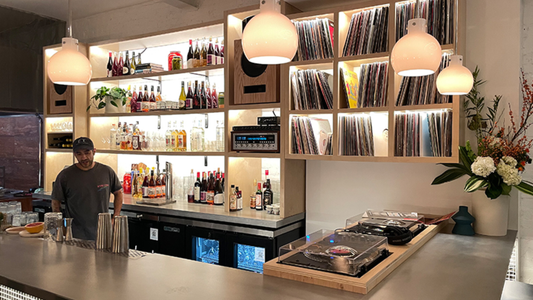
Promised Land: Volume Two – Various Artists (UK, 1995)
The Future Was Already Here
By Rafi Mercer
Some compilations don’t just collect tracks — they capture a moment. Promised Land: Volume Two, released in the mid-1990s on Strictly Underground Records, was one of those sets that felt less like a release and more like an artefact. Three slabs of vinyl, each side packed with new names, new sounds, and new ways of hearing rhythm.
It was the sound of Britain’s underground learning to speak for itself. Jungle and drum & bass weren’t genres then — they were reactions. A generation of kids from London, Birmingham, Bristol and Leeds were building something from what they had: turntables, samplers, and curiosity. The “promised land” wasn’t a place; it was the idea that freedom could have a beat.
Listening now, the energy still hums through the grooves. Every track feels like a snapshot from a late-night pirate broadcast — hiss, compression, bass rolling through tower blocks. But there’s also clarity: producers pushing primitive gear to its emotional limit, making technology feel human.
Side A opens with that unmistakable mixture of breakbeats and sub-bass — the rhythm sliced, shuffled, reassembled. What stands out isn’t aggression, but ingenuity. The Amen break chopped into liquid patterns; vocal fragments treated like percussion; basslines that don’t just underpin the rhythm but speak it. This was architecture built from improvisation.
Each side flows like a DJ set. Promised Land: Volume Two wasn’t curated for radio; it was made for rooms. The mix of tempos, moods, and tonalities creates a kind of cartography — darker cuts giving way to euphoric synth lines, rough edges softening into melody. You can almost see the warehouses, the smoke, the strobes, the bodies moving not to be seen but to belong.
For anyone coming to drum & bass later — through Goldie, Bukem, Roni Size — this record feels like the sketchbook before the museum. It’s full of ideas that would later be refined: the deep-space pads of atmospheric jungle, the swing of broken beat, the intensity of early techstep. Yet nothing here feels half-formed. The imperfections are the design.
What’s remarkable, even three decades on, is how emotional it all feels. Beneath the velocity lies warmth — a sense of optimism running through every track. The title, Promised Land, wasn’t accidental. These were multicultural, post-industrial kids dreaming something new out of concrete. They weren’t waiting to be signed; they were pressing their own futures into acetate.
Through a good system, the sound is alive — midrange crisp, bass immense but soft-edged. This is vinyl made to move air, not sell copies. The noise floor becomes part of the music. The low frequencies resonate like infrastructure — sound as structure.
In a listening bar, the effect is transformative. Drop one of these sides at volume and the room shifts instantly. The bass gathers beneath the tables; the percussion scatters like sparks. It’s not nostalgia — it’s presence. This is music that doesn’t date because it never pretended to be timeless. It was built for now, and that immediacy remains.
It’s easy to forget how radical this compilation was in its time. The early 1990s were dominated by imported dance music — house from Chicago, techno from Detroit. Promised Land marked the moment when Britain stopped importing and started exporting. Jungle wasn’t mimicry; it was mutation. It took American funk breaks, reggae bass, European synths, and London grit — and made something entirely its own.
What’s fascinating is how the spirit of that moment still echoes through modern British sound. You can hear it in the new wave of jazz from London, in the half-time experiments of electronic producers, in how rhythm itself has become architecture again. The cultural DNA that begins on records like Promised Land: Volume Two runs everywhere now — invisible but unmistakable.
The compilation format is part of the magic. No single vision, no dominant ego — just a community of ideas pressed together. Some tracks hit harder, some stumble, but the totality is the point. It’s a reminder that great movements are rarely planned; they emerge.
For collectors, the original triple-vinyl edition remains prized — heavy, minimal sleeve design, a promise etched into wax. But for listeners, it’s more than a relic. It’s an experience that still works — not as retro, but as root.
When I play it late at night, the effect is almost physical. The sub frequencies fill the space between heartbeat and floor. The high-end hiss feels like air moving through concrete. It’s music that reminds you that the best art often comes from limitation — from people working not with abundance, but with purpose.
That’s what this compilation represents: the sound of resourcefulness turned radiant. It’s Britain in transition — Thatcher’s shadow fading, digital horizons opening, optimism rebuilt from bass and imagination.
There’s a moment on Side D — one of those anonymous cuts where the break suddenly opens, the chords shimmer, and the whole thing feels weightless. You can almost hear the hope in it. That’s the promised land: not a destination, but a feeling that community, creativity, and sound might be enough to remake the world, even for a few minutes.
And when the needle lifts, that feeling remains — the hum of sub-bass still in the air, the sense that something real just passed through the room.
Rafi Mercer writes about the spaces where music matters. For more stories from Tracks & Tales, subscribe, or click here to read more.







